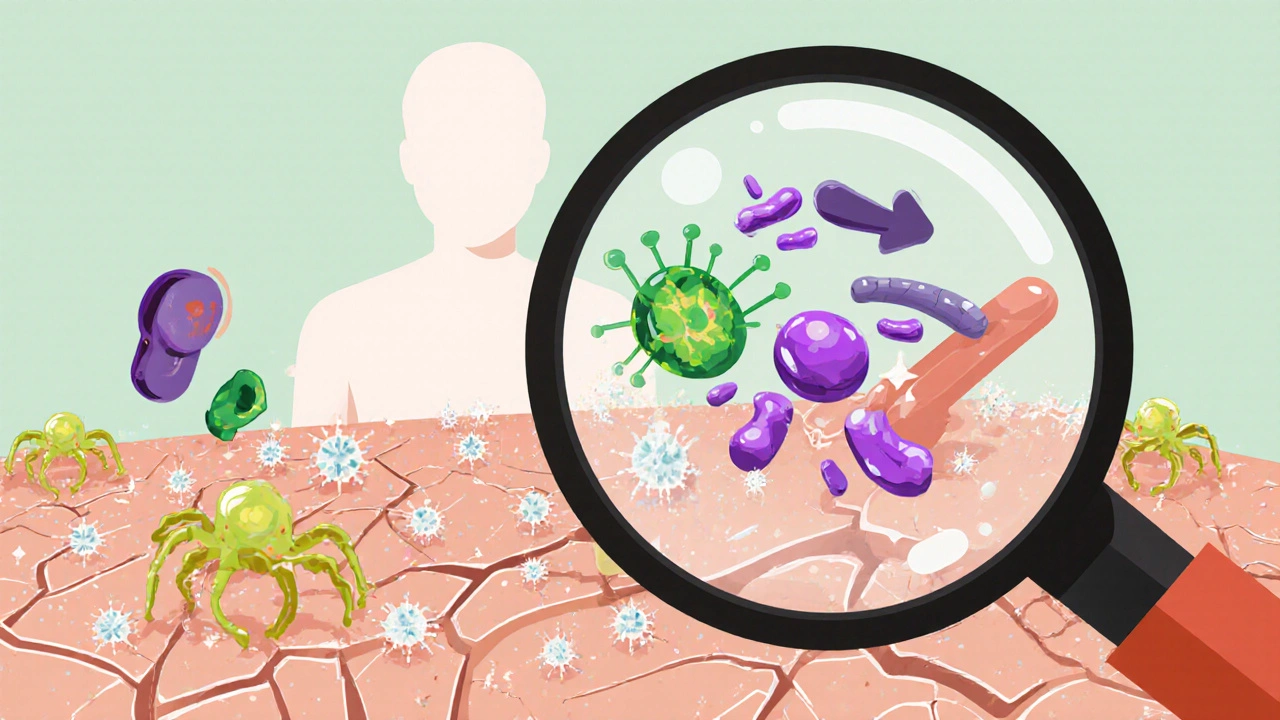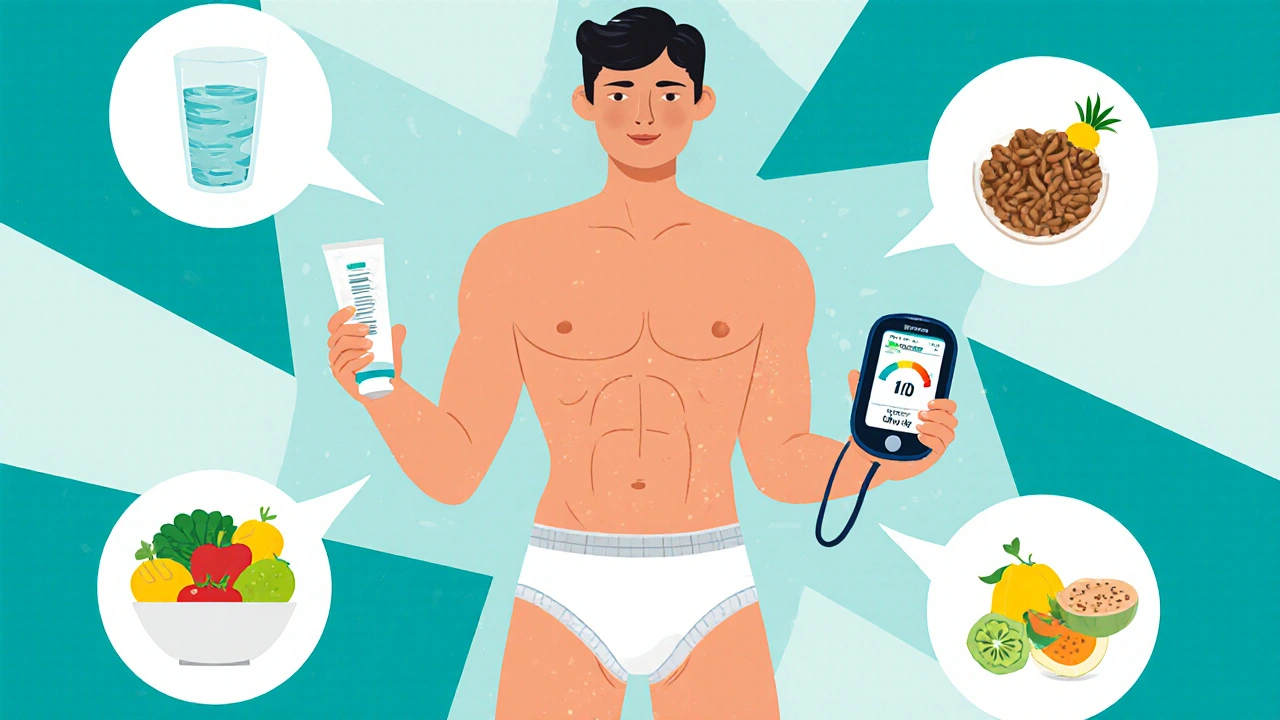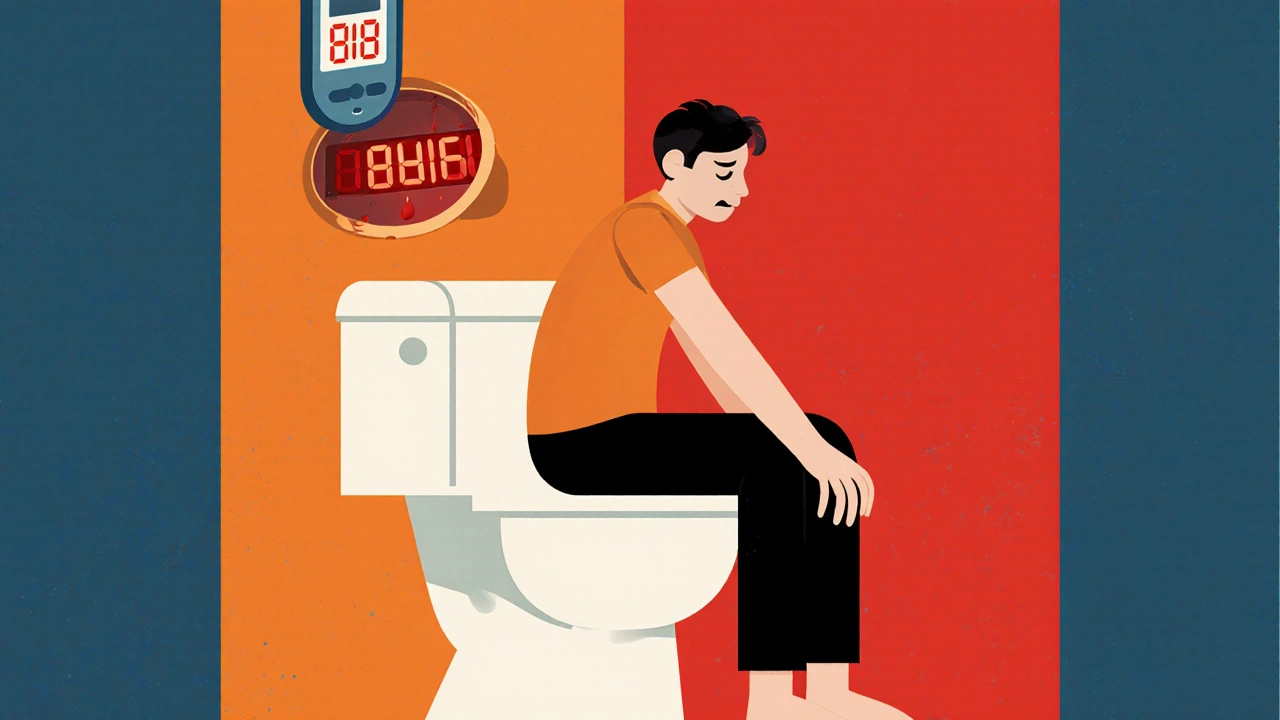Diabetes-Related Itching Risk Assessment
This assessment helps you determine if your anal itching might be related to diabetes. Based on the article's criteria, answer the following questions to get a risk assessment.
When a persistent urge to scratch the rear area shows up, most people think it’s just a hygiene issue. In reality, anal itching can be a signal that something deeper-like diabetes-is at play. This article breaks down why high blood sugar can turn a harmless itch into a chronic nuisance, and gives you clear steps to calm the rash before it worsens.
What is Anal Itching?
Anal itching is a common discomfort characterized by an urge to scratch the perianal skin, medically known as pruritus ani. The skin around the anus is thin and sensitive, so even minor irritation can feel intense. Typical triggers include poor wiping habits, moisture, and friction, but the condition often masks an underlying health problem.
Understanding Diabetes and Its Skin Effects
Diabetes is a metabolic disorder where the body either cannot produce enough insulin (type 1) or cannot use insulin effectively (type 2), leading to chronic high blood glucose levels. Over time, elevated glucose damages blood vessels, nerves, and skin integrity. The result? Dryness, reduced immunity, and a playground for infections that love warm, moist environments-like the area around the anus.
Why High Blood Sugar Makes the Area Itchy
Several mechanisms link diabetes to anal itching:
- Hyperglycemia draws water out of skin cells, causing dryness and cracking that exposes nerve endings.
- Excess sugar feeds fungal infections (especially Candida) which thrive in moist, warm spots.
- Elevated glucose impairs white‑blood‑cell function, so bacterial overgrowth (e.g., Staphylococcus) lingers longer.
- Diabetes often co‑exists with hemorrhoids, and swollen veins add pressure and irritation.
- Neuropathy reduces sensation, so minor scratches become unnoticed wounds that turn itchy.
All these factors create a feedback loop: itch leads to scratching, scratching damages skin, damage invites infection, infection fuels more itching.

Common Causes of Anal Itching in Diabetics vs Non‑Diabetics
| Trigger | More Likely in Diabetes | More Likely without Diabetes |
|---|---|---|
| Fungal infection (Candida) | ✓ | |
| Bacterial infection (Staph, E. coli) | ✓ | |
| Dry, cracked skin | ✓ | |
| Hemorrhoids | ✓ | ✓ |
| Allergic reaction to soaps or wipes | ✓ | |
| Pinworms (Enterobius) | ✓ |
Notice how fungal and bacterial infections dominate the diabetic column. If you’re diabetic and notice a new itch, those microbes should be the first suspects.
Spotting the Signs That Diabetes Is the Culprit
Beyond the itch itself, look for these clues that point toward a sugar‑related cause:
- Itch intensifies after meals or when blood glucose spikes.
- Skin around the anus appears dry, scaly, or has small red patches. \n
- There’s a white, cottage‑cheese‑like discharge-classic for a yeast infection.
- Accompanying symptoms such as frequent urination, increased thirst, or unexplained weight loss.
- Previous diagnosis of diabetic neuropathy or peripheral vascular disease.
If three or more of these appear together, a diabetes‑linked itchy episode is likely.
Managing Anal Itching When You Have Diabetes
Effective relief combines blood‑sugar control with local skin care:
- Optimize glucose levels: Aim for fasting glucose 80‑130mg/dL and post‑meal <140mg/dL. Consistent control reduces moisture and infection risk.
- Keep the area dry: After bathing, pat gently with a soft towel. Use a hair dryer on low, cool setting if needed.
- Use a barrier cream containing zinc oxide or petrolatum to shield skin from stool irritation.
- If a fungal infection is suspected, apply over‑the‑counter antifungal powder (e.g., miconazole 2%) for 7‑14 days.
- For bacterial overgrowth, a short course of topical bacitracin or oral antibiotics prescribed by a doctor can clear the infection.
- Adopt a diet low in refined sugars and refined carbs; fiber‑rich meals improve bowel regularity, reducing moisture.
- Stay hydrated to keep skin elasticity, but avoid sugary drinks that spike glucose.
Never ignore persistent itching-self‑treatment can mask a serious condition that needs professional attention.

When to Seek Professional Help
Contact a healthcare provider if any of the following occur:
- The itch lasts longer than two weeks despite home care.
- There’s bleeding, ulceration, or a lump that doesn’t shrink.
- You notice a foul odor or pus discharge.
- It interferes with sleep or daily activities.
- You have a new diagnosis of diabetes and the itch appears suddenly.
Doctors may perform a visual exam, swab for cultures, and check your HbA1c to gauge long‑term glucose control. In rare cases, a skin biopsy rules out inflammatory disorders like psoriasis.
Prevention: Keeping the Itch at Bay
Long‑term prevention hinges on a few simple habits:
- Monitor blood glucose daily and adjust meds or diet as needed.
- Wear breathable, cotton underwear; avoid tight synthetic fabrics that trap moisture.
- Practice gentle cleansing: warm water wash, no harsh soaps, and a quick pat‑dry.
- Apply a thin layer of barrier ointment after each bathroom visit.
- Schedule regular foot and skin checks with your diabetes care team; early detection stops problems from spreading.
These steps create a dry, protected environment that’s hostile to fungi and bacteria, while also keeping blood sugar in a range that won’t irritate skin.
Frequently Asked Questions
Can anal itching be the first sign of diabetes?
Yes, especially in type2 diabetes where skin changes often appear before classic symptoms. Persistent itching, dryness, or yeast infections around the anus should prompt a blood‑sugar test.
Are over‑the‑counter creams safe for diabetics?
Most topical antifungal and barrier creams are safe, but avoid products with high alcohol content that can dry the skin further. If you have open sores, check with a clinician before applying anything.
How does neuropathy affect anal itching?
Neuropathy dulls sensation, so minor scratches aren’t felt. The skin may become damaged without you noticing, leading to infection and later, more intense itching when nerves finally react.
Is a high‑fiber diet useful?
Yes. Fiber promotes regular bowel movements, reducing moisture and irritation in the anal area. Aim for 25‑30g of fiber daily from fruits, vegetables, and whole grains.
When should I see a dermatologist instead of a GP?
If the itch is accompanied by persistent rash, color changes, or doesn’t respond to standard treatments after two weeks, a dermatologist can provide specialized skin testing and targeted therapies.


Nhasala Joshi
October 17, 2025 AT 20:51When you hear the sweet siren of high‑fructose corn syrup, remember that the sugar lobby is quietly wiring our nerves to itch for more 😱. The covert agenda isn’t just about calories, it’s about creating a feedback loop that ties metabolic chaos to dermal distress 🕵️♂️. Hyperglycemia draws water out of epidermal cells, leaving the perianal skin desiccated and cracked like old parchment 🍭. Those micro‑cracks expose nociceptors, turning even a gentle breeze into a maddening sting. Meanwhile, excess glucose fuels opportunistic yeasts such as Candida albicans, which love warm, moist niches and produce pruritic metabolites 🦠. The compromised immune surveillance in diabetic patients allows these microbes to flourish unchecked, amplifying inflammatory cytokines. Add to that the prevalence of hemorrhoidal varices in the diabetic population, and you have an anatomical pressure cooker ready to explode with irritation. Neuropathy further dulls the protective sensation, so minor abrasions go unnoticed until they become infected and unbearably itchy. The cascade is self‑reinforcing: itch leads to scratching, scratching deepens fissures, fissures invite infection, infection fuels more itch. Hidden in this cycle is the silent influence of pharmaceutical marketing that pushes sugary drug excipients, subtly worsening glycemic spikes. Government health agencies often downplay the dermatological sequelae of chronic hyperglycemia, preferring to focus on cardiovascular outcomes. This omission is a strategic distraction, keeping the public from questioning why a simple glucose test can predict an anal rash. The truth is that every gram of sugar you consume is a tiny agent of dermal sabotage, covertly infiltrating your skin barrier. 🧬 To break the chain, you must master glycemic control, adopt antifungal hygiene protocols, and demand transparency from food regulators. Only then can you reclaim comfort in the most intimate region of your body 🌟.
Wyatt Schwindt
October 22, 2025 AT 23:15Keep your blood sugar steady and use a gentle fragrance‑free barrier cream after wiping.
Lyle Mills
October 28, 2025 AT 00:39Hyperglycemia creates osmotic stress on keratinocytes, leading to micro‑fissures that act as entry points for Candida.
Barbara Grzegorzewska
November 2, 2025 AT 03:03Honestly, the whole "just wipe better" narrative is a half‑baked excuse crafted by mainstream media to avoid confronting the Americn sugar‑fuelled health crisis. You think the government cares about your anal itch? They’re too busy polishing their flags while relishing the profits from sweetened soda empires. If you really want relief, stop feeding the beast and start demanding real education on glycemic impact, not that lazy pamphlet about toilet paper brands.
Nis Hansen
November 7, 2025 AT 05:27Consider the itch as a reminder that mind, body, and metabolic equilibrium are intertwined; when one part falters, the whole system signals for correction. By aligning your diet, mindfulness, and diligent skin care, you create a virtuous cycle that restores harmony.
Natala Storczyk
November 12, 2025 AT 07:51Wow!!! This is exactly why we must take charge now!!! The urgency cannot be overstated!!! Your skin is screaming for help, and every delay magnifies the damage!!! Don't ignore the warning signs-act with decisive, bold steps!!!
nitish sharma
November 17, 2025 AT 10:15It is imperative, dear readers, to adopt a regimen that balances glycemic regulation with meticulous perianal hygiene. I respectfully advise the utilization of a pH‑balanced cleanser followed by a barrier ointment, coupled with consistent monitoring of blood glucose levels.
Rohit Sridhar
November 22, 2025 AT 12:39First, congratulations on taking the first step toward better health!
Now, let’s break it down: maintain optimal glucose, use a mild, unscented wipe, and keep the area dry. If you notice any redness, consider a topical antifungal. Remember, consistency beats occasional effort-stay persistent and you’ll see improvement.
Sarah Hanson
November 27, 2025 AT 15:03Make sure the area stays dry, avoid harsh soaps, and consider a probiotic regimen.
kendra mukhia
December 2, 2025 AT 17:27Listen up, folks! If you think an itchy behind is just a minor inconvenience, you’re grossly underestimating the systemic havoc a poorly managed diabetic body can unleash. The science is clear, and the facts are undeniable-your blood sugar spikes are the hidden puppeteers behind that relentless itch.
Bethany Torkelson
December 7, 2025 AT 19:51Stop ignoring the signs! Take control of your glucose, treat the infection, and end the endless scratching cycle now.